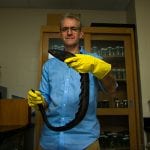Research Interests
Dr. Crampton’s research program investigates the ecological, behavioral, and evolutionary mechanisms that generate and regulate species diversity. With more than 6,000 species, Neotropical freshwater fishes represent the richest vertebrate fauna on earth (c. 10% of all vertebrates). The Crampton lab is interested in how this diversity is generated and maintained, how resilient it is to human pressure, and how it can be protected. To approach these questions the lab uses, as a model group, the gymnotiform electric knifefishes. These remarkable fishes generate stereotyped, species-specific electric communication signals that provide an unparalleled opportunity to understand the mechanisms of diversification. The lab is currently focusing on reproductive isolating mechanisms in pulse-generating gymnotiforms, and on a taxonomic revision of the families Gymnotidae and Hypopomidae. Dr. Crampton and his collaborators are also undertaking a long term program of freshwater fish biodiversity inventories in the Amazon basin.
Publications
Selected Publications
- de Santana, C.D. & Crampton, W.G.R. (2011). Phylogenetic interrelationships, taxonomy, and reductive evolution in the Neotropical electric fish genus Hypopygus (Teleostei, Ostariophysi, Gymnotiformes). Zoological Journal of the Linnean Society 163: 1096-1156.
- Crampton, W.G.R. (2011). An ecological perspective on diversity and distributions. Pp. 165-189. In:Historical Biogeography of Neotropical Freshwater Fishes (Eds. J.S. Albert & R.E. Reis).University of California Press, Berkeley
- Crampton, W.G.R., Lovejoy, N.R., and Waddell, J.C. (2011). Reproductive character displacement and signal ontogeny in a sympatric assemblage of electric fishes. Evolution 65 (6): 1650-1666.
- Arnegard, M.E., McIntyre, P.B., Harmon, L.J., Zelditch, M.L., Crampton, W.G.R., Davis, J.K., Sullivan, J.P., Lavoué, S., & Hopkins, C.D. (2010). Sexual signal evolution outpaces ecological divergence during electric fish species radiation. American Naturalist 176 (3): 335-356. Featured in: Leal, M. & Losos, J. B. (2010). Communication and speciation (News and Views: Evolutionary Biology) Nature 467: 159-160.
- Lovejoy, N.R., Lester, K., Crampton, W.G.R., Marques, F.P.L. & Albert, J.S. (2010). Phylogeny, biogeography, and electric signal evolution of Neotropical knifefishes of the genus Gymnotus(Osteichthyes: Gymnotidae). Molecular Phylogeny and Evolution 54 (1): 278-290.
- de Santana, C.D. & Crampton, W.G.R. (2010). A review of the South American electric fish genusPorotergus (Gymnotiformes: Apteronotidae) with the description of a new species. Copeia 2010 (1): 165-175.
- Crampton, W.G.R., Davis, J.K., Lovejoy, N.R., & Pensky, M. (2008). Multivariate classification of animal communication signals: A simulation-based comparison of alternative signal processing procedures using electric fishes. Journal of Physiology, Paris. 102: 304-321.
- Milhomem, S.S.R., Pieczarka, J.C., Crampton, W.G.R., Silva, D.S., de Souza, A.C.P., Carvalho, J.R., & Nagamachi, C.Y. (2008). Chromosomal evidence for a putative cryptic species in theGymnotus carapo species-complex (Gymnotiformes, Gymnotidae). BMC Genetics 9: 75 1-10.
- Crampton, W.G.R. (2007). Diversity and adaptation in deep channel Neotropical electric fishes. Pp. 283-339. In: Fish Life in Special Environments (Eds. P. Sebert, D.W. Onyango, & B.G. Kapoor). Science Publishers, Enfield, N.H.
- de Santana, C.D. & Crampton, W.G.R. (2007). Revision of the deep-channel electric fish genusSternarchogiton (Gymnotiformes: Apteronotidae). Copeia 2007 (2): 387-402.
- Crampton, W.G.R. & Albert, J.S. (2006). Evolution of electric signal diversity in gymnotiform fishes. I. Phylogenetic systematics, ecology and biogeography. Pp. 647-696 and 718-731. In:Communication in Fishes (Eds. F. Ladich, S.P. Collin, P. Moller, & B.G Kapoor). Science Publishers, Enfield, NH.
- Crampton, W.G.R. (2006). Evolution of electric signal diversity in gymnotiform fishes. II. Signal design. Pp. 697-731. In: Communication in Fishes (Eds. F. Ladich, S.P. Collin, P. Moller, & B.G Kapoor). Science Publishers, Enfield, NH.
Highlights
November 2010:
University of Central Florida biologist Will Crampton, an internationally recognized expert in electric eels and other electric fishes, co-stars in an episode full of excitement of “Dangerous Encounters,” a documentary series on the National Geographic Channel. Crampton offers his expertise about these amazing creatures – and is shocked by one of the eels — as television host Brady Barr films the trek deep into the Amazonian forests of Suriname, on the northern coast of South America.
“Dangerous Encounters” follows Barr as he travels around the globe to study reptiles and other creatures in their native habitats. The “Giant Eel” episode airs at 9 p.m. on Friday, Nov. 19.
September 2010:
12 September 2010. Will Crampton’s film about electric eels will be aired for the first time on the US National Geographic Television channel (it has already been released in Europe and South America) on November 19 2010
“In this episode of Dangerous Encounters, Dr. Brady Barr travels to the heart of the Central Suriname Nature Preserve with Dr. William Crampton of University of Central Florida in search of an incredibly dangerous fish, the electric eel. Upon arrival to the reserve, Brady observes that the water levels of the Coppename River are extremely high making the finding of this creature a much more difficult task. Eventually after some intense searching, Brady finds his first eel and his capture results begin to improve. Assisted by Will Crampton and the local Maroon community, Brady learns about electroreception in these fishes and the habitat that they live in. Along the way Brady will encounter venomous snakes and swarming piranhas, and the rare Suriname Toad.”
September 2010:
9 September 2010. A paper that Dr William Crampton co-authored recently in The American Naturalist was covered in a News and Views article in today’s edition of Nature. The paper in American Naturalist is entitled “Sexual signal evolution outpaces ecological divergence during electric fish species radiation” and was lead by Matt Arnegard, a post-doc at Dolph Schluter’s lab at the University of British Colombia. This collaboration was somewhat of a departure from Crampton’s usual research in that it involves African mormyriform electric fishes, not the Neotropical gymnotiform electric fishes. Crampton’s main contribution to the paper was to design a wavelet-based procedure for multivariate signal analysis. Justin Davis, a PhD student from the UCF Mathematics Department, worked closely with Crampton on this contribution and is also a co-author on the paper.



